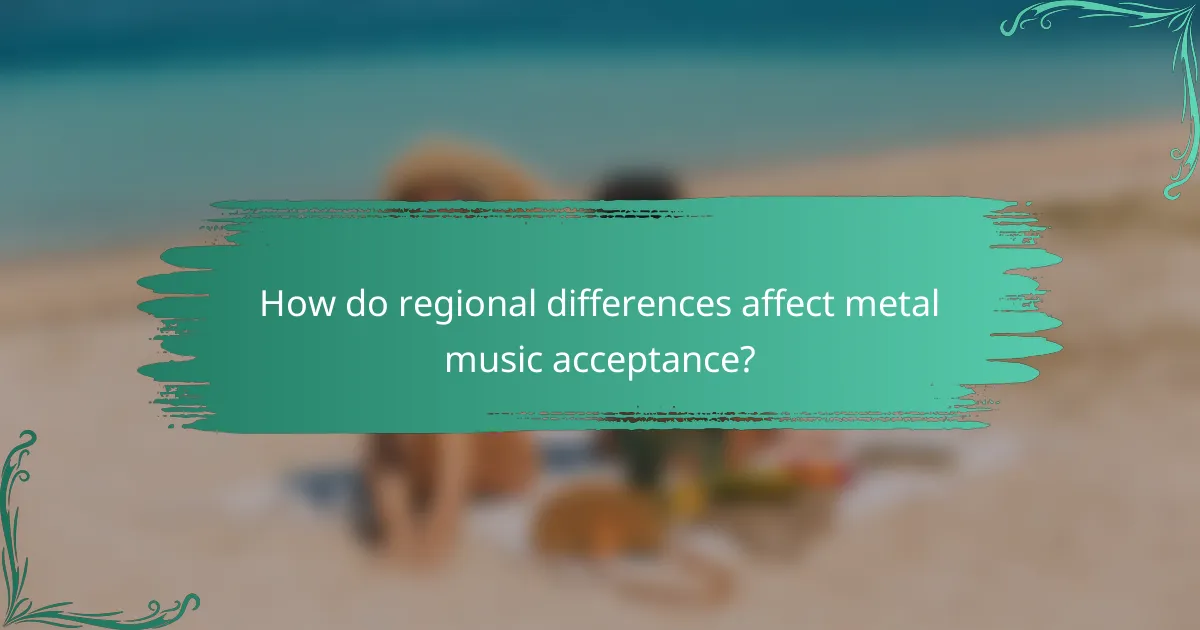Metal music has emerged as a diverse and influential genre with varying degrees of acceptance around the globe. Its cultural significance is deeply intertwined with local values and social issues, leading to unique sounds and styles that reflect regional traditions. The genre’s global reach has been amplified by digital streaming platforms and social media, fostering community and exposure across different cultures.

How is metal music perceived globally?
Metal music is perceived as a diverse and influential genre worldwide, with varying degrees of acceptance and popularity across different regions. Its cultural significance often reflects local values, social issues, and musical traditions.
Acceptance in Europe
In Europe, metal music enjoys widespread acceptance and is often celebrated as a key part of the cultural landscape. Countries like Germany, Sweden, and Finland have vibrant metal scenes, with numerous festivals such as Wacken Open Air and Download Festival attracting thousands of fans each year.
European metal bands often gain international recognition, contributing to the genre’s global reach. The support from local communities and dedicated fan bases further solidifies metal’s status in this region.
Popularity in North America
North America has a robust metal music scene, particularly in the United States and Canada, where genres like heavy metal, thrash, and death metal have thrived since the 1980s. Major festivals like Ozzfest and Knotfest showcase both established and emerging artists, drawing large crowds.
Metal’s popularity in North America is also reflected in album sales and streaming numbers, with many bands achieving significant commercial success. However, the genre faces competition from other music styles, requiring artists to innovate to maintain relevance.
Cultural significance in Asia
In Asia, metal music holds a unique cultural significance, often blending with local musical traditions. Countries like Japan and India have developed their own metal subgenres, incorporating traditional instruments and themes.
Metal festivals in Asia, such as the Loud Park festival in Japan, highlight the growing fan base and the genre’s ability to resonate with younger audiences. The rise of social media has also helped Asian metal bands gain international exposure.
Influence in South America
South America has a passionate metal community, with countries like Brazil and Argentina being notable hotspots. The genre often serves as a form of expression against social and political issues, resonating deeply with local audiences.
Festivals like Rock in Rio and Monsters of Rock showcase both local and international acts, emphasizing the region’s vibrant metal culture. South American metal bands frequently tour internationally, further spreading their influence.
Emerging scenes in Africa
Africa is witnessing the emergence of diverse metal scenes, with countries like South Africa, Nigeria, and Kenya leading the way. Local bands are blending traditional African music with metal, creating unique sounds that reflect their cultural heritage.
Festivals such as the South African Metal Festival are crucial for promoting local talent and fostering community. As the global metal community becomes more interconnected, African metal is gaining recognition and appreciation worldwide.

What are the cultural variations of metal music?
Cultural variations of metal music reflect the diverse influences and traditions of different regions, leading to unique sounds and styles. Each area incorporates local musical elements, themes, and cultural narratives, resulting in a rich tapestry of metal genres worldwide.
Subgenres in the United States
The United States is home to a wide array of metal subgenres, including heavy metal, thrash, death metal, and black metal. Each subgenre often reflects the socio-political climate, personal struggles, and cultural narratives of American life. For example, thrash metal, popularized by bands like Metallica and Slayer, often addresses themes of rebellion and societal issues.
Regional scenes, such as the Bay Area thrash movement or the Southern metal scene, contribute to the diversity within American metal. This variety allows for a broad spectrum of sounds, from the melodic elements of power metal to the aggressive tones of hardcore metal.
European metal styles
Europe boasts a rich metal heritage, with distinct styles emerging from various countries. For instance, Scandinavian countries are known for their black metal, characterized by its dark themes and atmospheric soundscapes, with bands like Mayhem and Darkthrone leading the charge. In contrast, the UK has made significant contributions to heavy metal and its evolution, with iconic bands like Iron Maiden and Black Sabbath.
Additionally, genres like folk metal and symphonic metal have gained popularity in Europe, blending traditional music elements with heavy metal. This fusion creates a unique listening experience that often celebrates local folklore and history.
Asian metal influences
Asian metal music incorporates a variety of cultural influences, resulting in unique styles that reflect local traditions. Countries like Japan have developed their own metal scenes, with bands such as X Japan and Babymetal fusing metal with pop and traditional Japanese music. This blend creates a distinctive sound that appeals to both metal fans and a broader audience.
In India, the metal scene is growing, with bands like Bhayanak Maut and Demonic Resurrection infusing local musical elements and languages into their music. This cultural integration enriches the genre and showcases the versatility of metal across different societies.
Latin American metal characteristics
Latin American metal is marked by its vibrant energy and fusion of local musical styles, such as salsa and cumbia, with traditional metal elements. Bands like Sepultura from Brazil have gained international acclaim by incorporating Brazilian rhythms and themes into their music, creating a unique sound that resonates with both local and global audiences.
The metal scene in Latin America often addresses social issues, political struggles, and cultural identity, making the music deeply relevant to its listeners. Festivals and local shows play a crucial role in promoting these bands, fostering a strong sense of community and cultural pride within the metal genre.

What are the key factors driving metal music’s global reach?
The global reach of metal music is primarily driven by digital streaming platforms, international festivals, and the impact of social media. These factors facilitate access, community building, and exposure to diverse audiences, allowing metal to thrive across various cultures.
Digital streaming platforms
Digital streaming platforms like Spotify, Apple Music, and YouTube have revolutionized how metal music is consumed worldwide. They provide easy access to a vast library of metal tracks, enabling listeners to discover both mainstream and underground artists from different countries.
These platforms often feature curated playlists and algorithm-driven recommendations that help fans find new music tailored to their tastes. As a result, metal bands can reach audiences far beyond their local scenes, increasing their global fanbase.
International festivals
International metal festivals, such as Wacken Open Air in Germany and Download Festival in the UK, play a crucial role in promoting metal music globally. These events attract thousands of fans from various countries, creating a unique environment for cultural exchange and collaboration among artists.
Festivals often showcase a mix of established and emerging bands, providing exposure to diverse subgenres and styles. Attending these festivals allows fans to experience the global metal community firsthand, fostering a sense of belonging and shared passion.
Social media impact
Social media platforms like Facebook, Instagram, and Twitter have significantly impacted the way metal music is shared and promoted. Bands and fans use these platforms to connect, share content, and engage in discussions, creating a vibrant online community.
Through social media, metal bands can promote their music, announce tours, and interact with fans directly. This direct engagement helps build loyalty and encourages fans to support their favorite artists, contributing to the genre’s growth and acceptance worldwide.

How do regional differences affect metal music acceptance?
Regional differences significantly influence the acceptance of metal music, shaping how it is perceived and embraced within various cultures. Factors such as local regulations, music scenes, and fan demographics play crucial roles in determining the popularity and accessibility of metal across different areas.
Regulatory environments
Regulatory environments can either promote or hinder the growth of metal music in specific regions. In some countries, strict censorship laws may limit the expression of themes common in metal, such as rebellion or social critique. For example, nations with strict media regulations may restrict access to certain lyrics or performances, impacting the genre’s visibility.
Conversely, regions with more liberal regulations often see a thriving metal scene, where bands can freely express their artistic vision. Countries like Sweden and Germany, known for their supportive music policies, have robust metal communities that continue to flourish.
Local music scenes
The local music scene is a vital component of metal music acceptance, as it fosters community and engagement among fans and artists. In areas with a rich history of live music, such as the United States and the UK, metal bands often find a supportive audience eager to attend concerts and festivals. This active participation helps to solidify metal’s place in the local culture.
In contrast, regions lacking established music venues or a vibrant live music culture may struggle to cultivate a dedicated metal following. For instance, in some parts of Eastern Europe, limited access to live performances can hinder the growth of local metal bands, making it challenging for them to gain traction.
Fan demographics
Fan demographics play a significant role in shaping the acceptance of metal music. Different age groups, social classes, and cultural backgrounds can influence how metal is received. Younger audiences, often more open to diverse music genres, may embrace metal more readily than older generations who might have different musical preferences.
Additionally, the cultural background of fans can affect their connection to metal. In countries where metal is associated with counterculture movements, such as Brazil or Finland, fans may feel a stronger sense of identity and community within the genre. Understanding these demographic factors can help bands tailor their approach to reach wider audiences effectively.
![]()
What role do iconic bands play in cultural acceptance?
Iconic bands significantly shape cultural acceptance by bridging gaps between diverse communities and mainstream society. Their influence often leads to increased visibility and legitimacy for metal music, fostering a broader appreciation across various demographics.
Metallica’s influence in mainstream culture
Metallica has played a pivotal role in bringing metal music into the mainstream, particularly through their albums in the late 1980s and early 1990s. Their self-titled album, often referred to as “The Black Album,” achieved massive commercial success, introducing millions to the genre.
The band’s collaborations with artists from different genres and their appearances in major media have further solidified their status. This crossover appeal has helped normalize metal music, making it more accessible to a wider audience.
Iron Maiden’s global fanbase
Iron Maiden boasts a dedicated global fanbase that transcends cultural boundaries, with concerts drawing thousands in countries from Brazil to Japan. Their elaborate stage shows and storytelling lyrics resonate with fans, creating a sense of community among diverse groups.
The band’s commitment to touring extensively has allowed them to connect with fans worldwide, fostering cultural acceptance of metal music in regions where it was previously less popular. Their influence can be seen in the growing number of local metal bands inspired by their sound and ethos.
Black Sabbath’s legacy
Black Sabbath is often credited with laying the groundwork for heavy metal music, influencing countless bands and shaping the genre’s identity. Their dark themes and heavy sound challenged societal norms, prompting discussions around music’s role in culture.
Their legacy continues to impact new generations of musicians, who draw inspiration from Black Sabbath’s pioneering work. As a result, the band’s contributions have played a crucial role in the broader acceptance of metal as a legitimate and respected musical genre.

What are the emerging trends in metal music?
Emerging trends in metal music include the fusion of genres, increased diversity in themes, and the rise of digital platforms for distribution and collaboration. These trends reflect the genre’s adaptability and its global reach, allowing for new sounds and cultural influences to shape its evolution.
Genre Fusion
Genre fusion is becoming increasingly popular in metal music, with artists blending elements from various styles such as electronic, hip-hop, and even classical music. This blending creates unique subgenres, like electronicore and symphonic metal, attracting a broader audience and keeping the sound fresh.
For example, bands like Bring Me the Horizon and Spiritbox incorporate electronic elements and pop influences, appealing to fans beyond traditional metal circles. This trend allows for creative experimentation and can lead to innovative musical experiences.
Diversity in Themes
Metal music is expanding its thematic scope, moving beyond traditional topics of rebellion and darkness to explore personal, social, and political issues. Artists are increasingly addressing mental health, identity, and environmental concerns, resonating with a wider audience.
For instance, bands like Architects and Gojira tackle themes of climate change and existentialism, reflecting contemporary societal challenges. This shift not only broadens the lyrical landscape but also invites listeners to engage with meaningful content.
Digital Platforms and Collaboration
The rise of digital platforms has transformed how metal music is created, shared, and consumed. Artists now utilize social media, streaming services, and online collaboration tools to reach global audiences and collaborate with musicians from different backgrounds.
Platforms like Bandcamp and SoundCloud allow independent artists to distribute their music directly to fans, bypassing traditional record labels. This democratization of music production fosters a diverse range of voices and styles within the metal community.
